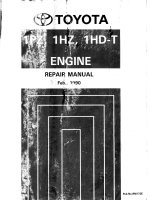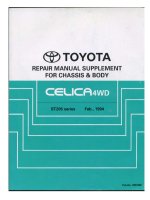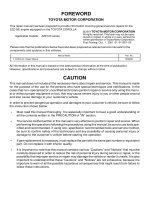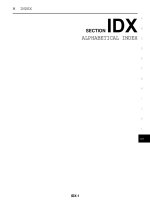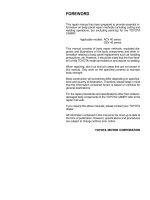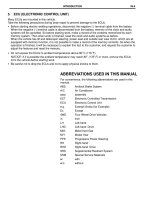Toyota camry 2006 2011 body repair manual hướng dẫn sửa chữa thân xe toyota camry đời 2006 2011
Bạn đang xem bản rút gọn của tài liệu. Xem và tải ngay bản đầy đủ của tài liệu tại đây (12.91 MB, 164 trang )
FOREWORD
This repair manual has been prepared to provide essential in-
formation on body panel repair methods (including cutting and
welding operations, but excluding painting) for the TOYOTA
CAMRY.
Applicable models: ACV 40 series
GSV 40 series
This manual consists of body repair methods, exploded dia-
grams and illustrations of the body components and other in-
formation relating to body panel replacement such as handling
precautions, etc. However, it should be noted that the front fend-
ers of this TOYOTA model are bolted on and require no welding.
When repairing, don’t cut and join areas that are not shown in
this manual. Only work on the specified contents to maintain
body strength.
Body construction will sometimes differ depending on specifica-
tions and country of destination. Therefore, please keep in mind
that the information contained herein is based on vehicles for
general destinations.
For the repair procedures and specifications other than collision-
damaged body components of the TOYOTA CAMRY refer to the
repair manuals.
If you require the above manuals, please contact your TOYOTA
dealer.
All information contained in this manual is the most up-to-date at
the time of publication. However, specifications and procedures
are subject to change without prior notice.
ABOUT THIS MANUAL
Scope of the repair work explanation
D This text explains the welding panel replacement instructions from the vehicle’s white body condi-
tion. We have abbreviated the explanations of the removal and reinstallation of the equipment parts
up to the white body condition and of the installation, inspection, adjustment and final inspection of
equipment parts after replacing the weld panel.
Section categories
D This manual has been divided as shown below.
Section Title Contents Examples
INTRODUCTION
Explanation of general body repair.
Views of weld panel replacement instructions.
Cautionary items.
Views of weld panel replacement instructions.
BODY PANEL REPLACEMENT
Instructions for replacing the weld panels
from the white body condition, from which
bolted parts have been removed, with
individual supply parts.
Front side member replacement.
Quarter panel replacement.
BODY DIMENSIONS Body aligning measurements. Dimension diagrams.
PAINT D COATING
Scope and type of anti-rust treatment, etc.
together with weld panel replacement.
Under coating.
Body sealer.
Contents omitted in this manual.
D Make sure to perform the following essential procedures, although they are omitted in this manual.
(1) Clean and wash removed parts, if necessary.
(2) Visual inspection.
F33003
F33000
F33001
F33002
Glass Cover
Seat Cover
WRONG
WRONG
INTRODUCTION
IN-1
PRECAUTION
GENERAL REPAIR INSTRUCTIONS
1. WORK PRECAUTIONS
(a) VEHICLE PROTECTION
(1) When welding, protect the painted surfaces, windows,
seats and carpet with heat resistant, fireproof covers.
(b) SAFETY
(1) Never stand in a direct line with the chain when using a
puller on the body or frame, and be sure to attach a
safety cable.
(2) Before performing repair work, check for fuel leaks.
If a leak is found, be sure to close the opening com-
pletely.
(3) If it is necessary to use a flame in the area of the fuel
tank, first remove the tank and plug the fuel line.
(c) SAFETY WORK CLOTHES
(1) In addition to the usual mechanic’s wear, cap and
safety shoes, the appropriate gloves, head protector,
glasses, ear plugs, face protector, dust-prevention
mask, etc. should be worn as the situation demands.
Code Name
A Dust-Prevention Mask
B Face Protector
C Eye Protector
D Safety Shoes
E Welder’s Glasses
F Ear Plugs
G Head Protector
H Welder’s Gloves
INTRODUCTION
F33014
F33015
IN-2
PRECAUTIONS FOR REPAIRING BODY
STRUCTURE PANELS
1. HEAT REPAIR FOR BODY STRUCTURE
PANELS
Toyota prohibits the use of the heat repair method on body
structure panels when repairing a vehicle damaged in a col-
lision.
Panels that have high strength and rigidity, as well as a long
life span for the automobile body are in high demand.
At Toyota, in order to fulfill these requirements, we use high
tensile strength steel sheets and rust preventive steel
sheets on the body. High tensile steel sheets are made with
alloy additives and a special heat treatment in order to im-
prove their strength.
To prevent the occurrence of rust for a long period of time,
the surface of the steel is coated with a zinc alloy.
If body structure parts are heat repaired with an acetylene
torch or other heating source, the crystalline organization of
the steel sheet will change and their strength of the steel
sheet will be reduced. The ability of the body to resist rust is
significantly lowered as well since the rust resistant zinc
coating is destroyed by heat and the steel sheet surface is
oxidized.
2. STRUCTURE PANEL KINKS
A sharp deformation angle on a panel that cannot be re-
turned to its original shape by pulling or hammering is
called a kink.
Structural parts are designed to perform in their original
shape. If parts are deformed in an accident, or if the de-
formed parts are repaired and reused, the parts may be un-
able to perform as intended.
It is necessary to replace the part where the kink has oc-
curred.
F33016
F33017
INTRODUCTION
IN-3
3. IMPACT BEAM REPAIR
The impact beam and bracket are necessary and important
parts that help reduce the probability of injury to passen-
gers in side collisions.
For impact beams, we use special high tensile strength
steel.
The high tensile strength steel maintains its special crystal-
line organization by heat treatment or alloy additives.
Structural parts are designed to perform in their original
shape. If parts are deformed in an accident, or if the de-
formed parts are repaired and reused, the parts may be un-
able to perform as intended.
If the impact beam or bracket is damaged, replace the door
assembly that has the damaged beam.
Also, the bumper reinforcement is a necessary and impor-
tant part that helps reduce the probability of injury to pas-
sengers in front collisions, and for the same reasons ex-
plained above, should be replaced if damaged.
F33020
F33021
F33022
F33007
Cutting Okay
Reinforcement
Corners
WRONG
Body Measument Diagrams
INTRODUCTION
IN-4
PROPER AND EFFICIENT WORK
PROCEDURES
1. REMOVAL
(a) PRE-REMOVAL MEASURING
(1) Before removal or cutting operations, take measure-
ments in accordance with the dimensions diagram. Al-
ways use a puller to straighten a damaged body or
frame.
(b) CUTTING AREA
(1) Always cut in a straight line and avoid cutting rein-
forced areas.
(c) PRECAUTIONS FOR DRILLING OR CUTTING
(1) Check behind any area to be drilled or cut to ensure
that there are no hoses, wires, etc., that may be dam-
aged.
HINT: See “Handling Precautions on Related Compo-
nents” on page IN-9.
(d) REMOVAL OF ADJACENT COMPONENTS
(1) When removing adjacent components, apply protec-
tive tape to the surrounding body and your tools to pre-
vent damage.
HINT: See “Handling Precautions on Related Compo-
nents” on page IN-9.
F10011A
F33008
F33009
F33023
F33024
Less than
3 mm
Puncher
Air Saw
20 − 30 mm Overlap
INTRODUCTION
IN-5
2. PREPARATION FOR INSTALLATION
(a) SPOT WELD POINTS
(1) When welding panels with a combined thickness of
over 3 mm (0.12 in.), use a MIG (Metal Inert Gas)
welder for plug welding.
HINT: Spot welding does not provide sufficient dura-
bility for panels with a combined thickness of over 3
mm (0.12 in.)
(b) APPLICATION OF WELD-THROUGH PRIMER
(SPOT SEALER)
(1) Remove the paint from the portion of the new parts
and body to be welded, and apply weld-through prim-
er.
(c) MAKING HOLES FOR PLUG WELDING
(1) For areas where a spot welder cannot be used, use a
puncher or drill to make holes for plug welding.
REFERENCE: mm (in.)
Thickness of welded portion Size of plug hole
1.0 (0.04) under ø 5 (0.20) over
1.0 (0.04) − 1.6 (0.06) ø 6.5 (0.26) over
1.7 (0.07) − 2.3 (0.09) ø 8 (0.31) over
2.4 (0.09) over ø 10 (0.39) over
(d) SAFETY PRECAUTIONS FOR ELECTRICAL
COMPONENTS
(1) When welding, there is a danger that electrical compo-
nents will be damaged by the electrical current flowing
through the body.
(2) Before starting work, disconnect the negative terminal
of the battery and ground the welder near the welding
location of the body.
(e) ROUGH CUTTING OF JOINTS
(1) For joint areas, rough cut the new parts, leaving 20 −
30 mm (0.79 − 1.18 in.) of overlap.
F33025
F10017A
F10018A
F33010
F10019A
WRONG
CORRECT WRONG
Tip Cutter
Old Spot Locations
New Spot Locations
INTRODUCTION
IN-6
3. INSTALLATION
(a) PRE-WELDING MEASUREMENTS
(1) Always take measurements before installing under-
body or engine components to ensure correct assem-
bly. After installation, confirm proper fit.
(b) WELDING PRECAUTIONS
(1) The number of welding spots should be as follows.
Spot weld: 1.3 X No. of manufacturer’s spots.
Plug weld: More than No. of manufacturer’s plugs.
(2) Plug welding should be done with a MIG (Metal Inert
Gas) welder. Do not gas weld or braze panels at areas
other than where specified.
(c) POST-WELDING REFINISHING
(1) Always check the welded spots to ensure that they are
secure.
(2) When smoothing out the weld spots with a disc grind-
er, be careful not to grind off too much as this will weak-
en the weld.
(d) SPOT WELD LOCATIONS
(1) Avoid welding over previously welded areas.
(e) SPOT WELDING PRECAUTIONS
(1) The shape of the tip point of the spot welder signifi-
cantly affects the strength of the weld. Therefore,
maintain the tip point in the proper shape, and allow it
to cool after every five or six spots.
(2) Completely remove the paint from the areas to be spot
welded, including the seams and the surfaces that
come in contact with the welding tip.
(3) Use a sander to remove any burrs that are created
during spot welding.
F33011
F33012
F33013
Sealer Gun
INTRODUCTION
IN-7
4. ANTI-RUST TREATMENT AFTER
INSTALLATION (BEFORE PAINTING
PROCESS)
(a) BODY SEALER APPLICATION
(1) For water-proofing and anti-corrosion measures, al-
ways apply the body sealer to the body panel seams
and hems of the doors, hood, etc.
(b) UNDERCOAT APPLICATION
(1) To prevent corrosion and protect the body from dam-
age by flying stones, always apply sufficient under
coating to the bottom surface of the under body and
inside of the wheel housings.
5. ANTI-RUST TREATMENT AFTER
INSTALLATION (AFTER PAINTING PROCESS)
(a) ANTI-RUST AGENT (WAX) APPLICATION
(1) To preserve impossible to paint areas from corrosion,
always apply sufficient anti-rust agent (wax) to the in-
side of the hemming areas of the doors and hood, and
around the hinges, or the welded surfaces inside the
box-shaped cross sections of the side members, body
pillars, etc.
F10024A
D Apply the anti-chipping paint after
the top coat.
D Apply the anti-chipping paint before
the second coat.
Anti-Chipping Paint
Top Coat
Second Coat
Under Coat (ED Primer)
Steel Metal
Top Coat
Second Coat
Anti-Chipping Paint
Under Coat (ED Primer)
Steel Metal
INTRODUCTION
IN-8
6. ANTI-RUST TREATMENT BY PAINTING
REFERENCE:
Painting prevents corrosion and protects the sheet
metal from damage. In this section, anti-chipping paint
only for anti-corrosion purposes is described.
(a) ANTI-CHIPPING PAINT
(1) To prevent corrosion and protect the body from dam-
age by flying stones, etc., apply anti-chipping paint to
the rocker panel, wheel arch areas, balance panel,
etc.
HINT:
Depending on the model or the application area, there
are cases where the application of anti-chipping paint
is necessary before the second coat or after the top
coat.
INTRODUCTION
IN-9
HANDLING PRECAUTIONS ON RELATED COMPONENTS
1. BRAKE SYSTEM
The brake system is one of the most important safety components. Always follow the directions and
notes given in the brake section of the repair manual for the relevant model year when handling brake
system parts.
NOTICE: When repairing the brake master cylinder or TRAC system, bleed the air out of the TRAC sys-
tem.
2. DRIVE TRAIN AND CHASSIS
The drive train and chassis are components that can have great effects on the running performance and
vibration resistance of the vehicle. After installing components in the sections listed in the table below,
perform alignments to ensure correct mounting angles and dimensions. Body repair must be particularly
accurate to ensure correct alignment.
HINT: Correct procedures and special tools are required for alignment. Always follow the directions giv-
en in the repair manual for the relevant model year during alignment and in section DI of this section.
Component to be aligned
Section of repair manual
for relevant model
Front Wheels Front Suspension section
Rear Wheels Rear Suspension section
3. COMPONENTS ADJACENT TO THE BODY PANELS
Various types of component parts are mounted directly on or adjacently to the body panels. Strictly ob-
serve the following precautions to prevent damaging these components and the body panels during han-
dling.
D Before repairing the body panels, remove their components or apply protective covers over the com-
ponents.
D Before prying components off using a screwdriver or a scraper, etc., attach protective tape to the tool
tip or blade to prevent damaging the components and the body paint.
D Before removing components from the outer surface of the body, attach protective tape to the body to
ensure no damage to painted areas.
HINT: Apply touch-up paint to any damaged paint surfaces.
D Before drilling or cutting sections, make sure that there are no wires, etc., on the reverse side.
4. ECU (ELECTRONIC CONTROL UNIT)
Many ECUs are mounted in this vehicle.
Take the following precautions during body repair to prevent damage to the ECUs.
D Before starting electric welding operations, disconnect the negative (−) terminal cable from the bat-
tery.
When the negative (−) terminal cable is disconnected from the battery, the memory of the clock and
audio systems will be erased. So, before starting work, make a record of the contents memorized by
each memory system. Then when work is finished, reset the clock and audio systems as before.
When the vehicle has tilt and telescopic steering, power seats and outside rear view mirrors, which are
all equipped with a memory function, it is not possible to make a record of the memory contents.
When the operation is finished, it will be necessary to explain this fact to the customer, and request the
customer to adjust the features and reset the memory.
D Do not expose the ECUs to ambient temperatures above 80_C (176_F).
NOTICE: Since it is possible that the ambient temperature may reach 80
_
C (176
_
F) or more, remove
the ECUs from the vehicle before starting work.
D Be careful not to drop the ECUs and not to apply physical shocks to them.
INTRODUCTION
C123719
CURTAIN SHIELD AIRBAG
ASSEMBLY LH
SRS WARNING LIGHT
FRONT PASSENGER AIRBAG ASSEMBLY
SPIRAL CABLE
FRONT SEAT OUTER
BELT ASSEMBLY RH
DRIVER SIDE KNEE
AIRBAG ASSEMBLY
STEERING PAD
FRONT SEAT OUTER BELT ASSEMBLY LH
COMBINATION METER ASSEMBLY: CLOCK ASSEMBLY:
CURTAIN SHIELD AIRBAG ASSEMBLY RH
CENTER AIRBAG SENSOR ASSEMBLY
PASSENGER AIRBAG ON/OFF INDICATOR
IN-10
DAMAGED VEHICLE DISPOSAL PRECAUTION (SRS AIRBAG SYSTEM)
For SRS airbag system adjustment methods, refer to the TOYOTA Repair Manual.
(1) When using an electric welder, first remove all airbags and the seat belt pretensioner.
(2) If impacts are likely to occur to the front airbag sensor, side airbag sensor, rear airbag sensor or seat
position sensor, remove each sensor as necessary beforehand.
(3) Do not allow the front airbag sensor, side airbag sensor, rear airbag sensor or seat position sensor to
become heated to high temperatures.
C123718
FRONT AIRBAG SENSOR RH
FRONT SEAT SIDE AIRBAG ASSEMBLY RH
SIDE AIRBAG SENSOR RH
REAR AIRBAG SENSOR RH
FRONT AIRBAG SENSOR LH
SIDE AIRBAG SENSOR LH
REAR AIRBAG SENSOR LH
SEAT POSITION SENSOR
FRONT SEAT INNER BELT ASSEMBLY LH
OCCUPANT CLASSIFICATION ECU
FRONT SEAT SIDE AIRBAG ASSEMBLY LH
INTRODUCTION
IN-11
INTRODUCTION
IN-12
HANDLING PRECAUTIONS OF PLASTIC BODY PARTS
1. The repair procedure for plastic body parts must conform with the type of plastic material.
2. Plastic body parts are identified by the codes in the following table.
3. When repairing metal body parts adjoining plastic body parts (by brazing, frame cutting, welding, paint-
ing etc.), consideration must be given to the properties of the plastic.
Code
Material
name
Heat
*
resistant
temperature
limit DC (DF)
Resistance to
alcohol or gasoline
Notes
AAS
Acrylonitrile
Acrylic Styrene
80
(176)
Alcohol is harmless if applied only for
short time in small amounts (e.g., quick
wiping to remove grease).
Avoid gasoline and organic
or aromatic solvents.
ABS
Acrylonitrile
Butadiene Styrene
80
(176)
Alcohol is harmless if applied only for
short time in small amounts (e.g., quick
wiping to remove grease).
Avoid gasoline and organic
or aromatic solvents.
AES
Acrylonitrile
Ethylene Styrene
80
(176)
Alcohol is harmless if applied only for
short time in small amounts (e.g., quick
wiping to remove grease).
Avoid gasoline and organic
or aromatic solvents.
ASA
Acrylonitrile
Styrene
Acrylate
80
(176)
Alcohol is harmless if applied only for
short time in small amounts (e.g., quick
wiping to remove grease).
Avoid gasoline and organic
or aromatic solvents.
EPDM
Ethylene
Propylene
100
(212)
Alcohol is harmless.
Gasoline is harmless if applied only for
short time in small amounts.
Most solvents are harmless
but avoid dipping in gasoline,
solvents, etc.
PA
Polyamide
(Nylon)
80
(176)
Alcohol and gasoline are harmless. Avoid battery acid.
PBT
Polybutylene
Terephthalate
160
(320)
Alcohol and gasoline are harmless. Most solvents are harmless.
PC Polycarbonate
120
(248)
Alcohol is harmless.
Avoid gasoline, brake fluid,
wax, wax removers and
organic solvents. Avoid alkali.
POM
Polyoxymethylene
(Polyacetal)
100
(212)
Alcohol and gasoline are harmless. Most solvents are harmless.
PP Polypropylene
80
(176)
Alcohol and gasoline are harmless. Most solvents are harmless.
PMMA
Polymethyl
Methacrylate
80
(176)
Alcohol is harmless if applied only for
short time in small amounts.
Avoid dipping or immersing
in alcohol, gasoline,
solvents, etc.
PVC
Polyvinylchloride
(Vinyl)
80
(176)
Alcohol and gasoline are harmless if
applied only for short time in small
amounts (e.g., quick wiping to remove
grease).
Avoid dipping or immersing
in alcohol, gasoline,
solvents, etc.
TPO
Thermoplastic
Olefine
80
(176)
Alcohol is harmless.
Gasoline is harmless if applied only for
short time in small amounts.
Most solvents are harmless
but avoid dipping in gasoline,
solvents, etc.
TSOP
TOYOTA
Super
Olefine Polymer
80
(176)
Alcohol and gasoline are harmless. Most solvents are harmless.
*Temperatures higher than those listed here may result in material deformation during repair.
F30269
Roof Drip Side Finish Moulding (TPO)
Cowl Top Ventilator Louver (PP/TSOP)
Radiator Grille (ABS)
Headlight (PC/PP)
Outer Rear View Mirror (ABS/PA/AES)
Front Bumper Cover (TSOP)
Front Door Outside Handle (PC)
Emblem (AES)
Wiper Blade (PBT)
Ex. U.S.A:
Side Turn
Signal Light (ABS/PMMA)
Front Bumper Extension Mounting Bracket (TSOP)
Foglight (ASA/PBT)
Rear Door Outside Handle (PC)
Door Window Frame Moulding (PP)
Front Fender To Cowl Side Seal (PP/EPDM)
INTRODUCTION
IN-13
F30269A
Door Window Frame Moulding (ASA)
Emblem (TSOP)
Rear Light (ASA/PMMA)
Licence Plate Light (PC)
Rear Bumper (TSOP)
Rear Combination Light (ASA/PMMA)
Emblem (ABS)
Door Belt Moulding (POM/PVC)
Rocker Panel Mounting (TSOP)
Luggage Compartment Opening
Door Outside Garnish (TSOP)
INTRODUCTION
IN-14
97
F30267
Adhesive Application Area
Formed material application areas (refer to PC-8)
Over 440Mpa High strength steel
. . .
. . .
Over 590Mpa High strength steel
. . .
Laser welding (12points)
INTRODUCTION
IN-15
ABOUT THIS VEHICLE
STRUCTUAL OUTLINE
D100366
Front
: JACK POSITION
: SUPPORT POSITION,
PANTOGRAPH JACK POSITION
: CENTER OF VEHICLE GRAVITY
(unloaded condition)
INTRODUCTION
IN-16
NOTICE ABOUT VEHICLE CONDITION WHEN JACKING UP VEHICLE
1. NOTICE FOR USING JACK AND SAFETY STAND
D100367
F30268
Center of Lift
Rubber Attachment
Attachment
HINT:
Right and left set position
Place the vehicle over the center of the lift.
HINT:
Front and left set position
Place the attachments at the ends of the rubber plate surface, under the vehicle lift pad (A and C in the illustration).
Raise the plate slightly and reposition the vehicle so the top of the attachment (B in the illustration) is aligned with the
front side notch in the vehicle rocker flange.
CENTER OF VEHICLE
GRAVITY
(unloaded condition)
mm (in.)
Attachment Dimensions
85 mm (3.35 in.)
70 mm
(2.76 in.)
100 mm (3.94 in.)
200 mm (7.87 in.)
INTRODUCTION
IN-17
2. NOTICE FOR USING SWING ARM TYPE LIFT
3. NOTICE FOR USING PLATE TYPE LIFT
F30266
Confirmation Point Collision Direction Collision Force Absorption Direction
Front Body Pillar
Upper Reinforcement
Front Bumper
Reinforcement
Roof Reinforcement
Front Body Pillar
Reinforcement
Floor Cross Member
Center Pillar Reinforcement
Front Side Member
Rocker Panel Reinforecement
INTRODUCTION
IN-18
DAMAGE DIAGNOSIS
B137228
for 2GR-FE:
COOL AIR IN TAKE DUCT SEAL
RADIATOR GRILLE
PROTECTOR
RADIATOR GRILLE
PROTECTOR
FRONT BUMPER ASSEMBLY
INTRODUCTION
IN-19
COMPORNENTS
1. Front bumper
INTRODUCTION
B137743
FRONT BUMPER
SIDE RETAINER RH
FRONT BUMPER
ENERGY ABSORBER
FRONT BUMPER REINFORCEMENT
SUB-ASSEMBLY
FRONT BUMPER
SIDE RETAINER LH
34 (347, 25)
CAUTION:
The bolts and nuts must be tightened to the torque specification, as they are related to vehicle safety during a collision.
N
.
m (kgf
.
cm, ft.
.
lbf)
: Specified torque
34 (347, 25)
IN-20
B137225
N
.
m (kgf
.
cm, ft.
.
lbf)
: Specified torque
REAR BUMPER
SIDE SUPPORT RH
REAR BUMPER
SIDE RETAINER RH
REAR BUMPER
SIDE RETAINER LH
REAR BUMPER
SIDE SUPPORT LH
REAR BUMPER REINFORCEMENT
SUB-ASSEMBLY
WHEEL HOUSE REINFORCEMENT RH
REAR BUMPER BAR
WHEEL HOUSE REINFORCEMENT LH
REAR BUMPER PAD
REAR BUMPER ENERGY ABSORBER
REAR BUMPER PLATE LH
REAR BUMPER PAD
REAR BUMPER PLATE RH
68 (693, 50)
68 (693, 50)
CAUTION:
The bolts and nuts must be tightened to the torque specification, as they are related to vehicle safety during a collision.
INTRODUCTION
IN-21
2. Rear bumper
B137286
20 (204, 15)
N
.
m (kgf
.
cm, ft.
.
lbf)
: Specified torque
INSTRUMENT PANEL NO. 1
SPEAKER PANEL SUB-ASSEMBLY
INSTRUMENT PANEL NO. 2
SPEAKER PANEL SUB-ASSEMBLY
NO. 1 DEFROSTER NOZZLE GARNISH
for LH Side: for RH Side:
FRONT NO. 2 SPEAKER ASSEMBLY FRONT NO. 2 SPEAKER ASSEMBLY
FRONT PASSENGER
AIRBAG ASSEMBLY
INSTRUMENT PANEL
WIRE ASSEMBLY
INSTRUMENT PANEL NO. 1 REGISTER ASSEMBLY
FRONT PILLAR GARNISH CLIP
INSTRUMENT PANEL NO. 3 REGISTER ASSEMBLY
FRONT PILLAR GARNISH CLIP
FRONT PILLAR GARNISH RH
FRONT PILLAR GARNISH LH
INSTRUMENT PANEL SAFETY PAD ASSEMBLY
COMBINATION METER ASSEMBLY
without Smart Key System:
LOWER INSTRUMENT PANEL
FINISH PANEL
with Smart Key System:
LOWER INSTRUMENT PANEL
FINISH PANEL
INSTRUMENT CLUSTER FINISH PANEL
NO. 1 INSTRUMENT PANEL SUB-ASSEMBLY
Non-reusable part
CAUTION:
The bolts and nuts must be tightened to the torque specification, as they are related to vehicle safety during a collision.
INTRODUCTION
IN-22
3. Instrument panel
INTRODUCTION
B137285
N
.
m (kgf
.
cm, ft.
.
lbf)
: Specified torque
TURN SIGNAL SWITCH ASSEMBLY
WITH SPIRAL CABLE SUB-ASSEMBLY
STEERING PAD
STEERING COLUMN COVER
STEERING WHEEL ASSEMBLY
LOWER NO. 3 STEERING
WHEEL COVER
SHIFT LEVER KNOB
SUB-ASSEMBLY
FLOOR SHIFT POSITION
INDICATOR HOUSING
SUB-ASSEMBLY
UPPER CONSOLE REAR
PANEL SUB-ASSEMBLY
LOWER NO. 2 STEERING
WHEEL COVER
INSTRUMENT PANEL NO. 2
REGISTER ASSEMBLY
RADIO RECEIVER WITH HEATER
CONTROL PANEL ASSEMBLY
NO. 1 CONSOLE BOX INSERT FRONT
UPPER CONSOLE PANEL SUB-ASSEMBLY
NO. 2 INSTRUMENT CLUSTER
FINISH PANEL GARNISH
NO. 1 INSTRUMENT
CLUSTER FINISH
PANEL GARNISH
NO. 2 CONSOLE BOX INSERT FRONT
CONSOLE BOX CARPET
CENTER AIRBAG
SENSOR ASSEMBLY
CONSOLE BOX POCKET
CONSOLE BOX ASSEMBLY
2.0 (20, 18 in.
.
lbf)
50 (510, 37)
8.8 (90, 78 in.
.
lbf)
17.5 (179, 13)
CAUTION:
The bolts and nuts must be tightened to the torque specification, as they are related to vehicle safety during a collision.
IN-23


